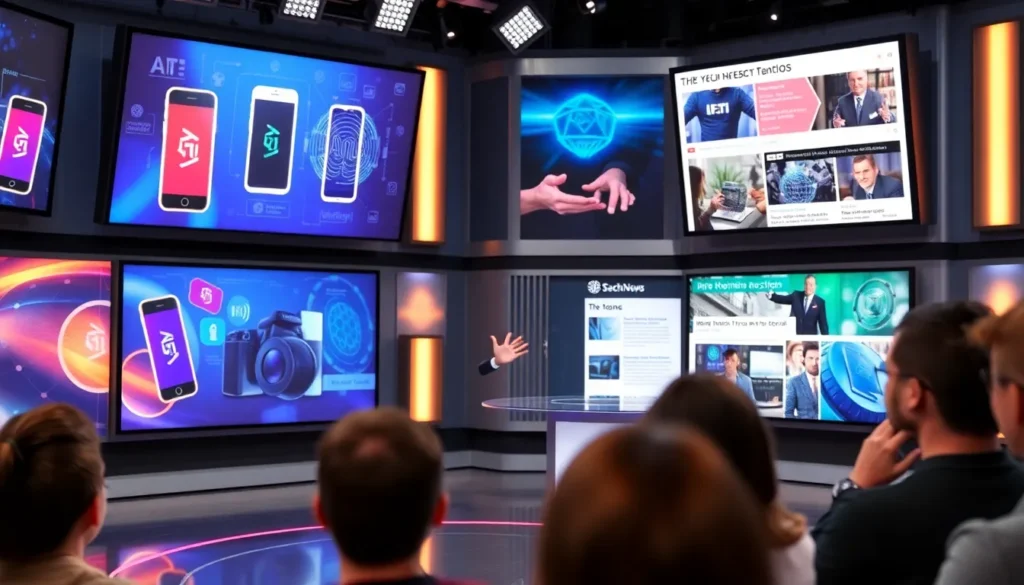In a world where products can make or break a business, mastering product design development is like finding the holy grail of success. It’s the secret sauce that transforms a mere idea into a market sensation. Whether it’s a quirky gadget or a sleek app, the journey from concept to creation is a thrilling rollercoaster ride filled with twists, turns, and a few unexpected drops.
Table of Contents
ToggleUnderstanding Product Design Development
Product design development plays a crucial role in turning concepts into successful market offerings. Mastering this field influences not only innovation in gadgets and applications but also the overall success of a business.
The Importance of Product Design
Effective product design serves as the foundation for meeting user needs and solving real-world problems. Competitors often rely on well-designed products to differentiate themselves in crowded markets. Attention to detail in design leads to enhanced user experience, fostering customer loyalty. Businesses that invest in strong product design usually see increased market share. Creating products that resonate with consumers often leads to successful sales trajectories and lasting brand reputation.
Key Phases in Product Design Development
Several essential phases exist in product design development. The ideation phase initiates the process, encouraging brainstorming and creativity. Following ideation, research and analysis of market needs guides informed decision-making. Prototyping involves creating tangible representations of ideas, which helps in visualizing and testing concepts. Feedback from testing ensures that designs meet requirements before final production. Lastly, iteration allows for adjustments based on user input, refining the final product for release. Implementing these phases effectively streamlines the journey from concept to market-ready product.
Research and Ideation

Research and ideation play a vital role in product design development. This phase helps teams understand user needs and market trends, guiding the creation of effective products.
Market Research Techniques
Numerous market research techniques exist to gather valuable insights. Surveys provide quantitative data, while interviews offer qualitative feedback. Focus groups encourage discussion among targeted users, revealing their preferences and pain points. Observational studies allow designers to witness user interactions with current solutions. Engaging in competitor analysis helps identify gaps in the market. Leveraging these techniques ensures that products address user demands and enhance competitive advantage.
Brainstorming and Concept Development
Brainstorming sessions foster creativity and collaborative thinking. Techniques such as mind mapping help visualize relationships between ideas. Sketching concepts enables quick exploration of possibilities. Team members should generate a wide range of ideas without judgment, promoting an open atmosphere. Concept development refines initial ideas into actionable plans. Creating personas aids in understanding target users and tailoring solutions to their needs. Collectively, these practices set the foundation for innovative product designs that resonate in the market.
Design and Prototyping
Effective design and prototyping are essential stages in product design development. These processes help translate ideas into tangible products that meet user demands.
Tools for Design Creation
Numerous tools foster creativity throughout the design creation phase. Adobe XD serves as a versatile platform for user interface design, allowing for quick mockups. Sketch offers an intuitive environment tailored for designing interfaces and user experiences. Figma stands out with its collaborative features, enabling teams to work seamlessly in real-time. Other tools such as Canva help visualize designs without extensive graphic design expertise. Utilizing the right tools streamlines the design process and enhances collaboration among team members.
Prototyping Methods
Prototyping methods vary based on project needs and complexity. Low-fidelity prototypes, such as sketches or paper models, allow designers to test initial concepts quickly. High-fidelity prototypes provide a more refined version that closely resembles the final product, useful for detailed testing. Interactive prototypes enable user testing in a realistic context, helping to gather valuable feedback on functionality. Rapid prototyping techniques, like 3D printing, speed up the iteration process and facilitate exploration of different ideas. Selecting effective methods boosts the overall quality of the final design.
Testing and Validation
Testing and validation are critical in ensuring a product meets user expectations and market needs. Establishing effective methods during these phases leads to valuable insights that guide final design decisions.
User Testing Approaches
User testing employs different methodologies to evaluate product performance and user interactions. A/B testing allows designers to compare two versions of a product and analyze user preference. Usability testing focuses on observing users as they navigate through a prototype, identifying pain points in real-time. Remote testing enables participants to provide feedback from various locations, expanding the testing pool. Contextual inquiry supports understanding user behavior in their natural environment, revealing insights not captured in controlled settings.
Feedback Integration
Integrating feedback is essential for refining product design. Prioritizing user feedback ensures design choices align with user needs and preferences. Analyzing feedback data uncovers patterns that highlight common issues or desires among users. Iterative testing allows designers to implement changes based on feedback quickly, leading to improved prototypes. Collaborative tools facilitate team discussions about feedback, creating an environment of shared insight and collective growth. Continuous iteration reinforces product relevance and quality in an evolving market.
Mastering product design development is vital for any business aiming to thrive in today’s competitive landscape. By focusing on user needs and leveraging effective research techniques, companies can create innovative products that stand out in the market.
The iterative nature of design ensures continuous improvement and adaptation, allowing businesses to respond to feedback swiftly. Each phase from ideation to testing plays a crucial role in refining concepts into market-ready solutions.
Ultimately, a well-executed product design development process not only enhances user experience but also builds brand loyalty and drives long-term success. Embracing these principles can lead to a stronger market presence and a more resilient business model.









